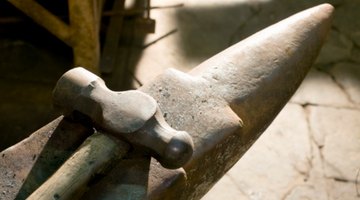Blacksmith Tools of the 1800s
One of the reasons blacksmiths are referred to as such is the fact that most of their tools turn black over time. Blacksmith tools of the 1800s evolved to include more modern tools such as the lathe and the vice. As more modern tools became available, blacksmiths were able to create more intricate works.

The Anvil
The anvil was used as a flat hard surface that allowed the blacksmith to hammer hot iron into whatever shape he needed. Anvils were used because they didn't burn or melt when put in contact with hot iron and wouldn't break under the heavy blow of the hammer. The first anvils were simply flat pieces of hard iron, but as time progressed anvils became much more dense and evolved to include the horn and the punch. The horn was a horn-shaped piece that allowed the blacksmith to pound hot metal into curved shapes, while the punch was a hole in the anvil that allowed the blacksmith to punch a hole all the way through the metal.
Vise
The vise was used to hold pieces of metal in place while they were being hammered. These tools were so dense that they could stand up to hammer blows just as well as the anvil. Placing the metal in the vise above the anvil removed the need to constantly hold it in place with the tongs. Having the metal held tightly in place like this also allowed the blacksmith to use both hands while hammering, which allowed him to put more force into each blow and allowed him much greater control of the hammer while pounding the metal into the desired shape.
Tongs
Tongs were used to allow the blacksmith to move hot metal without burning himself. These were used to take hot metal out of the fire and move it to the anvil. After the hot metal was hammered and molded the blacksmith would use the tongs to move the piece from the anvil to the water trough. The invention of the vice made tongs less necessary.
Water Trough
The water trough was used to speed up the cooling of hot metal. When the metal was done being molded the blacksmith would move it to the water trough to cool the piece. This would allow the blacksmith to have a better image of the final product as the glow from the high temperature would immediately die down. Having seen the final product the blacksmith would know whether any changes needed to be made to the iron and whether the project would have to be restarted from scratch.
References
Writer Bio
Devin Backman started writing professionally in 2004, with his work appearing in "The Alpenhorn News." He attended San Bernardino Valley College, majoring in journalism.
Photo Credits
- Tino Tedaldi/Polka Dot/Getty Images
- Tino Tedaldi/Polka Dot/Getty Images
More Articles



